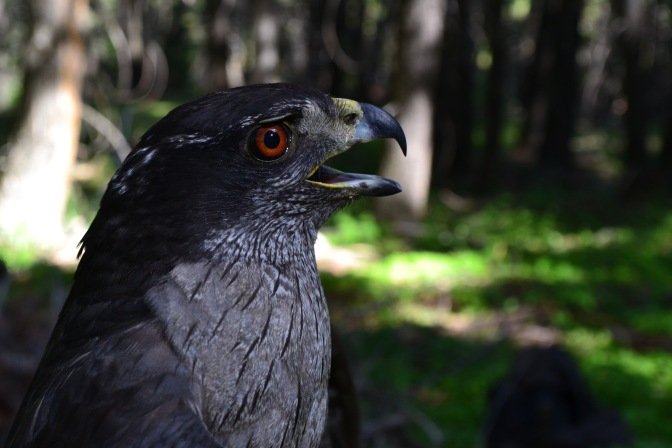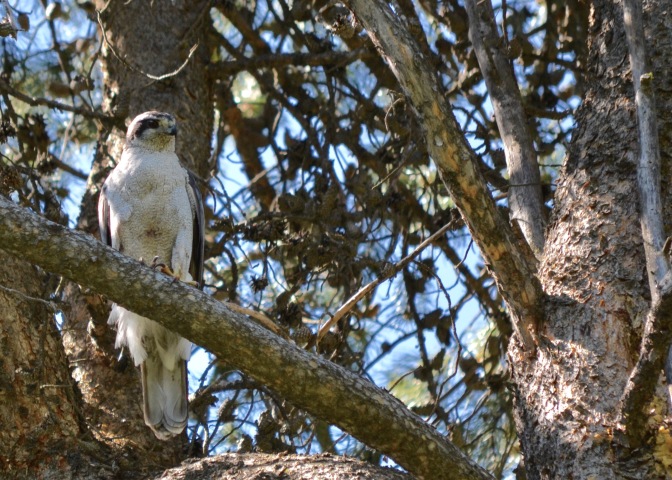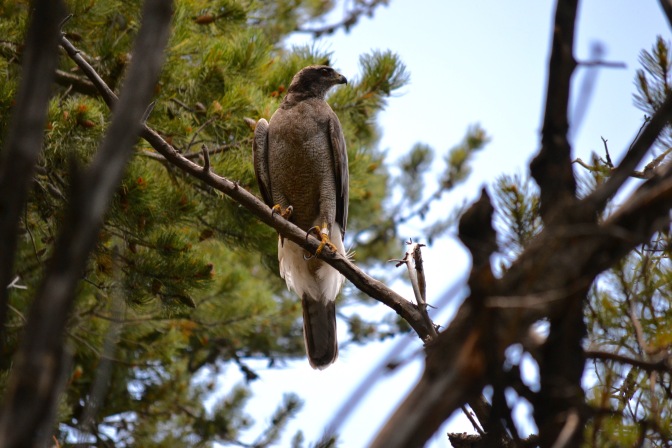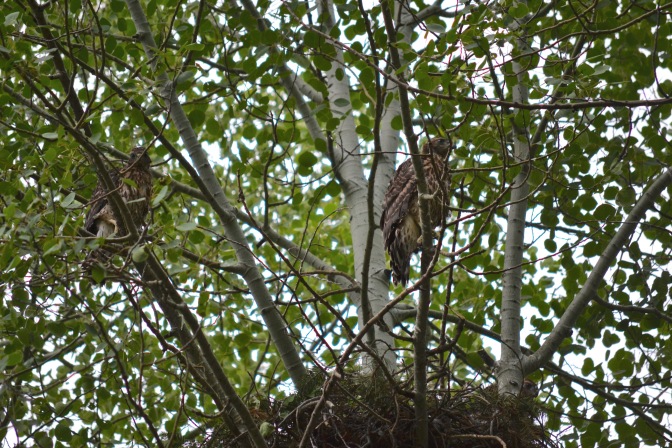I have just returned from my final trip into the mountains of southeast Idaho, home to the beautiful elusive Northern Goshawk. The main objectives of this outing were to band unbanded females in several territories and conduct productivity checks–count the young which survived to fledging (or nearly fledging) age.
We began by revisiting the second goshawk nest I had ever seen, back in the Albion Mountains, to trap and band the female. And we came prepared with a few new tactics. We brought a new stuffed owl for trapping that is less mangled than the other and was preserved in the familiar posture of a perched owl. We hypothesized from previous trapping failures that perhaps goshawks realize the hooting noise is not coming from the owl itself, since we are broadcasting the sound from one side of the net with a FoxPro. So, this time, I tried laying on the forest floor between the owl and the net so I could conceal the speaker under the tarp with me and control the sound. The female immediately responded to the hoots but was not approaching the owl. I decided to pick the owl up and hold it over my head to make it more visible for her.

I attempted to twist the owl so that its head, connected to the body with a metal rod, would spin in a somewhat-realistic way. I kept repositioning the owl to attract the attention of the female. I stopped playing the owl calls on the FoxPro and began making my own owl calls, which they responded to more than the recording. The male flew in and began calling along with his mate. This went on for about an hour. Rob finally stood up, ready to leave, which incited a sudden, aggressive response from the female. I continued to hold the owl and make owl sounds. She swooped in just above the net, close enough to catch a glimpse of the owl. Rob moved upslope and the female goshawk flew in his general direction before turning sharply to dive down on the owl. She swooped in right above me and I could feel the wind from her wings as she passed over and crashed into the net. I ran over to secure her and Rob and I carefully removed the netting from her tail, legs, wings, and then head. We banded her with a color band labeled S7.


Next, we moved on to the Subletts. This season, we only found one occupied nest in the areas of the Sublett Range which we surveyed. The nest was home to the first goshawk I ever banded–a female wearing band Z5 (you may remember her from my “First Encounters” post. I went in to check on the nest:


The Sublett nest was still occupied by one large nestling that I could see. There could have been other surviving fledglings elsewhere in the stand as well. The Z5 female of the Subletts was successful this breeding season!
As with any other wildlife narrative, I have at my disposal stories of incredible success and failure. We left the Subletts and went to visit three nests–one in the Black Pines, and two others in the Albions. In two of the three cases, we approached the nest stand, banding kit and trapping gear in hand, only to be bitterly disappointed to discover the nests had failed.
The failed nest in the Albions strikes a particularly vivid image in my mind. As we walked toward the nest, an eerie silence echoed through the forest. Even though we had visited this nest only a few weeks earlier, I hardly recognized the stand. Grazing cattle had destroyed the undergrowth all around the nest. Just a few meters from the nest tree, we found the remains of a nestling, surrounded by plucked feathers. Several paces away was another pile of juvenile feathers, and the nest was littered with feathers as well. The female was nowhere to be found, since nests are abandoned after a failure. It is possible that disturbance from livestock could have fueled a vocal response from the birds, attracting attention to the nest and distracting or exhausting the female until her ability to defend her young was impeded, allowing for predation by owls or other predators. We found the Black Pines nest abandoned as well, and suspect a similar mechanism caused the failure.
Disheartened by two failed nests in a row, we entered the other Albion nest we had intended to check. A path worn down by livestock led right up to the nest tree, which gave me a sinking feeling. At first, the nest appeared to be empty, and the female was absent. The signs of failure began to add up. I climbed upslope to gain a better view into the nest, and caught a glimpse of movement. An almost-fledging-age nestling was hunkered down in the nest. Relieved, we left the territory in higher spirits.
In addition to the failed nests, I was saddened by the amount of trash I found in every goshawk territory I visited. Rob and I found on four separate occasions foil balloons in nest stands. When a balloon is released, it must land somewhere, and they seem to overwhelmingly litter the forest floor. The number of beer and soda cans I picked off the ground and out of trees was outrageous. People like to bring old televisions among other large items out into the woods and shoot them up, leaving behind all the debris. During the four days I was in the field this time, I filled a large trash bag with items for recycling and one with trash.
In the South Hills, I checked on four nests on the first day. I visited a nest I had discovered in a territory with no known history of occupation. We had trapped the female the last time we were in the field, and I banded her with color band D9. Once I had a visual on the nest, I heard an alarm call. I looked up, and for the first time, saw a male defending his young without the female.

Normally, the female is the first to respond to threats to her nest, and the male will occasionally join her. Male goshawks tend to be much less aggressive and much more pathetic when it comes to defending the young. The mate of this female (banded D9) is an exception.
I could not see any young in the nest, but since I was getting such a response from the parent, I proceeded to search all around the nest for signs of fledglings. The male became more alarmed as I walked uphill from the nest. Whitewash covered the ground, and I found several shedded feathers. I glanced further upslope and caught sight of a strikingly handsome fledgling. Another success!


In the next territory I visited, the female, banded AK, made it very clear very early that I was not welcome. With impressive speed and agility, she wove herself around trees, zig-zagging her way through the forest towards my face, stretching out her talons as she neared. I began hiding behind trees, peeking out and then ducking to the other side of the trunk as she rushed past. This tactic allowed me to reach the nest tree and catch a glimpse of a nestling. From across the stand, I could hear at least one fledgling’s begging call. I had banded her four nestlings during our last trip to the South Hills when Rob climbed the tree into the nest, so I was elated to find them doing well.
However, I did not have time to admire the female’s success in raising her young past 35 days because her intensity was increasing yet. Somehow, she began to predict my movements and, at the last moment, would bank to the opposite side of the tree where I had planned on taking shelter. I resorted to clumsily hitting the forest floor on all fours. On my way out of the territory, she continued her fearless aerial attacks until I was more than 400 meters away from her nest. She has earned the title of most aggressive goshawk I have encountered.



Though I only confirmed that two of her young were alive and well, I see no reason that all four nestlings could not be hiding somewhere in the lodgepole pine stand. Her fierce protective instincts have made her a force to be reckoned with.
In the territory where I previously had my first resight of a color-banded bird (female P4), I discovered one dead nestling at the base of the nest tree. This nestling had likely died within the past week, since its remains were fresh and it looked to be of fledging age. The female wearing band P4 had upped her aggressiveness significantly since the last time we met. She dove at me repeatedly, and screamed at me relentlessly. A younger voice joined her with a squeaky alarm call. A fledgling was perched in a nearby tree, and upon making eye contact with me, took off from its resting place. I quickly made my way away from the nest to leave them in peace.
The final territory I visited was one I had not been to yet (Rob had found the nest occupied during the previous visit to the South Hills). I had no trouble finding the nest, since I heard several birds calling from the road. I was surprised and overjoyed to look up and find four healthy nestlings of fledging age, two of them branching, and two in the nest. Below the nest, I found the remains of at least three dead small mammals. These four siblings have eaten very well! In fact, once the parents showed up, I walked in the direction of their calls, and found the female with another piece of prey in her talons.

In our last day in the field, Rob and I set out to attempt to trap another female. Though we were unsuccessful in trapping, we confirmed that three nestlings had survived. Two had fledged, and one remained in the nest.
The South Hills goshawks were overall very successful in raising young this year. We know of at least three nests that fledged four young! The average was likely close to three fledglings per nest we checked.
As I look back on my first season of fieldwork, I have two thoughts: 1. Studying Northern Goshawks in the mountains of southeast Idaho is the coolest thing I have ever done; 2. I hope the data I collected can be interpreted and utilized by the U.S. Forest Service to continue to provide suitable habitat for nesting goshawks in this unique region.
Stay tuned for a post on some native plants and animals from my study area that I was able to capture with my camera!
Hmmm, effects of livestock grazing on goshawk nest success. Another study waiting to happen! You are lucky to have Rob as a boss too. He let you do a lot of cool things!
LikeLike
It is so cool to read about your adventures. I didn’t realize that these hawks were so aggressive when protecting their young.
LikeLike